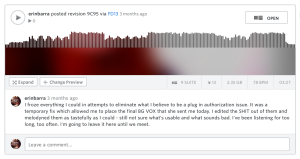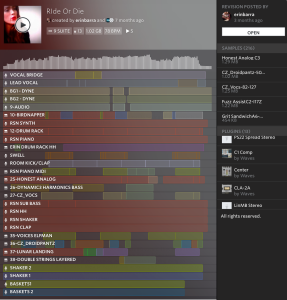Review: Splice — Cloud Platform for Music Creation, Collaboration and Sharing
In my opinion, cloud file management/sharing services are some of the coolest and most useful digital tools to come into the mainstream. Right now, everything I do gets uploaded to my own little plot of digital sky space, with a virtual white picket “security” fence around it, and I’m at a point where if The Cloud went down, it would be like a personal apocalypse.
But I’ve been of the opinion that the general User Experience and interfacing of most popular cloud services have left much to be desired, especially when it comes to specific professional fields, such as the music industry.
However mystifying or frightening the idea of sending all your session files and intellectual property to the cloud might be, it is really convenient, and most of us have already been forced to use Dropbox or Google Drive for work. To use the words and the eerily spot-on metaphor of Star Trek’s, Borg, “Resistance is futile. You will be assimilated”.
Sensing this ultimate trend and shift in the landscape, companies like Splice have stepped up to the plate to make your music making experience as creative as it can be — while taking care of the technical stuff for you, in the background.
Splice is a desktop app which synchs all your projects to the cloud and allows you to collaborate with any number of people within your own community or the global community at large.
It combines elements of music streaming, file hosting/synch and social media as well as some slick new ideas that create a platform which allows you to “create fearlessly” and acts as a tool for music makers of all kinds. To un-poetically sum it up for you, it’s like Soundcloud, Dropbox and Facebook all in one for producers and remix artists – and it’s currently in free public beta,
I just spent a good half-year soaking it in. What follows is the account of my 6 months on Splice.
Splice Life: Before…
Due to a heavy travel schedule, I do the majority of my collaborations with people I’m not in the same room with. When I was asked to do this review of Splice I was in the middle of co-writing and producing an album for a Seattle-based artist named Rita Boudreau that has a unique story.
First off, we wrote the entire album remotely from opposite sides of the country via Google hangouts, which worked surprisingly well. I’m based out of NY but work in Boston half the week, and the mix engineer/sound designer for this particular project is pretty much constantly on tour in Europe. Needless to say, the record was being made in the cloud. (Shout out to my collaborator Paul for joining me on this adventure!)
Pre-Splice, we had somewhat of an elaborate file management system in place which entailed dates, numbers, initials, locations and abbreviations, all of which were being synched via Dropbox. Example: IHopeYourHappy_eb2.7May8thBRSVoxMix1 (not kidding). It was working but I have to admit it was sort of a pain in the ass and I was always sifting through emails and finder windows to try to figure out where we had left off.
Then I got hooked up with the dudes over at Splice and they solved a bunch of my problems.
…After
I immediately uploaded all the Ableton Live Sessions from this particular album to the site from the point we had left off at and then invited Paul to join as a private collaborator.
Every project had its own dedicated page which visually represented each new published version of the session, or what was previously a “Save As,” in a way that was sort of like a forum post. I would see the waveform displayed across the top in a sort of Soundcloud-esque fashion, and below that I’d be provided with really useful information like file size, 3rd party plugs, BPM, length and any reference notes I attached. (See Fig. 1.1)

(Fig. 1.1) Publishing sessions to Splice includes the waveform and a wealth of information. (click to enlarge)
At a certain point during this 6-month review period, Splice introduced a new feature called the “DNA Player.” At its essence, the player consists of a visual representation of Arrangement View (fig 1.2), or the timeline, for those of you who aren’t familiar with Live’s many windows.
Not gonna lie, the first time I saw it I was sort of blown away. Splice figured out how to look at a session while being outside of the DAW, which mystified me in the same way the Cloud does to the majority of American’s.
After I got over the shock value of the whole thing I messed around a bunch with it. The coolest part about it is that you can make inline comments such as, “Turn down all snares 3db starting from here,” or “There’s a wrong note in the MIDI piano somewhere in this section. Will you check and fix?”, both of which are comments which came directly from my sessions.
Outside of that, the player doesn’t do much else, but I feel like this is one of those times where I don’t want to be quick to judge a feature. I imagine I’m only seeing a glimpse of the eventual functionality and power this idea of working “inside and outside” of the DAW could harness. My assessment of the player is that it’s really cool but I’d like to see more, and most likely will.
Splice and Space
The sessions themselves were about 1 Gb or so each in size at the upload point and consisted of an equal amount of audio and MIDI. My sessions tend to get very large so I was interested to see how Splice, who uses its own client separate from DropBox, was going to handle the files.
One thing I really liked about using Splice’s client was that it was basically free cloud space and it wasn’t dependent upon having an account with another service. I’ve run into issues with people I need to share files with only having the free DropBox account which maxes out at 2Gb, or my collaborator not paying the bill for their pro-account so they’d temporarily lose access.
Using Splice eliminated both of those issues but it makes me wonder how big this whole thing can get before the space either becomes a)not free or b)undependable. (Editor’s Note: A Splice spokesperson told SonicScoop that the company is “giving users totally free and unlimited storage, forever.”) Once the project files got to be around 4-5 Gb we experienced issues uploading and downloading from the client and actually went offline to do the final mix (Editor’s Note: According to a Splice spokesperson, this bug has been fixed).
Part of me was kind of disappointed that I wasn’t able to take it all the way to the finish line via the platform, but when you consider how much other time and file management woes I was saved, I can’t really be mad about it. Overall I’d say there were very good things and some not so good things I encountered, but I kinda feel the same way about Dropbox, so perhaps it’s a draw?
Is Splice Nice?
I’ve been using Splice for roughly six months now and I plan to continue using it — in fact I just uploaded a new project as I typed up this review. I may not be your typical “global collaborator” in the sense that I’m not the person searching for new people or content to work with, but I am in the sense that the people I’m already working with are all over the world.
I would definitely recommend giving Splice a try, regardless of whichever definition of “global collaborator” you consider yourself to be, because the bottom line is that it’s useful for everyone.
Splice also seems to have a lot of goals in the future, which are lofty to say the least, and could include things such as a premium service, a plugin marketplace, transparent licensing solutions as well as more stuff I’m not even at liberty to write about.
In addition to Ableton Live 8+, Splice currently supports FL Studio 11,Logic X, and Garageband. The platform has recently entered a public beta phase, so check it out! And please add your own thoughts in the comments section below.
— ERIN BARRA: Singer/Songwriter/Producer/Multi-Instrumenatlist/Ableton-Enthusiast/Nationally-Touring-Aritst. Also visit her on Facebook or Twitter @erinbarra
ERIN BARRA: Singer/Songwriter/Producer/Multi-Instrumenatlist/Ableton-Enthusiast/Nationally-Touring-Aritst. Also visit her on Facebook or Twitter @erinbarra
– See more at: https://www.sonicscoop.com/2014/08/26/review-focusrite-itrack-dock-ipad-audio-interface-by-erin-barra/#sthash.Jx159ZhK.dpuf
Please note: When you buy products through links on this page, we may earn an affiliate commission.









DPrty
January 15, 2015 at 10:02 pm (10 years ago)They don’t support Cockos Reaper?
Disappointed
March 26, 2015 at 5:03 pm (10 years ago)Splice doesn’t work from behind a proxy, and their support team doesn’t seem at all concerned.
Fiftyseven
February 17, 2016 at 9:00 pm (9 years ago)Nice article. I really enjoyed Erin’s Ableton crash course on Coursera.
B
January 25, 2017 at 12:31 pm (8 years ago)My experience with the Splice app was very good. I found the app very easy to use. Figuring out how to mute the audio on the real video clips to do a voice over was kind of challenging, but upon discovering how to do that, recording audio over the actual video clip was not hard at all.
I really liked how there was no minimum or maximum limit on the length of the video. Also being able to use the app without being interrupted by ads and the video not being watermarked by the app name was very enjoyable and great for the project I was doing in the app.
I also liked the simple selection of transitions, filters, and music. Although there were not many, there was enough to choose from for the project I was doing.
Although it is a very useful app for getting simple projects done, like school projects, I do not think it would work well for a professional project unless the video clips/pictures were taken on a better camera than a phone camera.